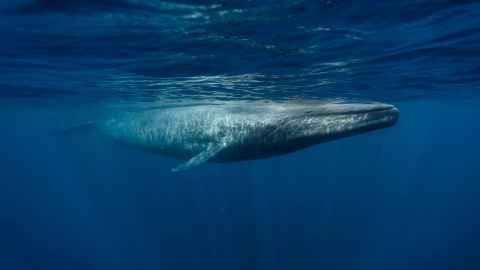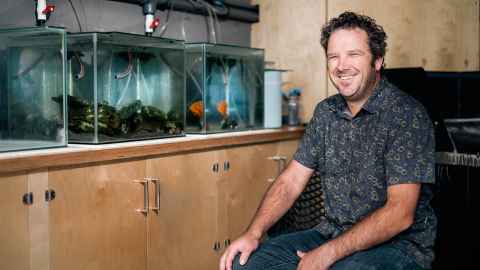Glub, glub, glub… a sound library of the underwater world
21 February 2022
Most people don’t know that the underwater world has dawn and dusk choruses, similar to those of the birds on land.

Kina feed at those times, scraping algae off the rocks with their teeth, a feasting that is noisy because the crunching sounds are amplified by the urchins’ hard, dome-shaped bodies. (Here’s the sound of kina feeding.)
From the clicks of dolphins to the crackling that divers hear (snapping shrimp), the underwater world is alive with sound.
Now, a group of international scientists including the University of Auckland’s Associate Professor Craig Radford, of the Faculty of Science, aims to set up a Global Library of Underwater Biological Sounds, or GLUBS.
A scientific paper by 17 experts, “Sounding the Call for a Global Library of Biological Underwater Sounds,” sets out the case in the journal Frontiers in Ecology and Evolution. The lead author is Miles Parsons of the Australian Institute of Marine Science.
Their goal is a vast reference library of underwater sounds that anyone can access, and which will grow even bigger with the addition of recordings from scientists and citizen scientists.
The backdrop is the alarming decline in healthy coral reefs, biodiversity and animal numbers, caused by climate change and overfishing.
Just as artificial intelligence has enabled facial or voice recognition, it can one day help scientists distinguish marine life sounds from noise
“At a time when worldwide biodiversity is in significant decline and underwater soundscapes are being altered as a result of anthropogenic impacts, there is a need to document, quantify, and understand biotic sound sources – potentially before they disappear,” the scientists write.
Microphones underwater help scientists to track marine life responses to changes in temperature, salinity, and tides; algal blooms, hurricanes and extreme weather; and human-caused noise pollution from shipping, resource exploration, construction, aircraft or wind turbines.
In New Zealand, Dr Radford and his colleagues at the Leigh Marine Laboratory north of Auckland have shown how anthropogenic noise interferes with communication by whales and fish. He’s also exploring the potential to monitor biodiversity by listening to reefs’ sound signatures.
In the GLUBS paper, the scientists note that listening to the sea has revealed great whales swimming in unexpected places, as well as new species and new sounds.
Here are some more samples of underwater sounds:
With sound, “biologically important areas can be mapped; spawning grounds, essential fish habitats, and migration pathways can be delineated … These and other questions can be queried on broader scales if we have a global catalogue of sounds.”
Comparing sounds from a single species across broad areas and times helps scientists to understand their diversity and evolution.

Numerous marine animals have worldwide presences, the paper says, “either as wide-roaming individuals, such as the great whales, or as broadly distributed species, such as many fishes.”
Fin whale calls, for example, can differ among populations in the Northern and Southern hemispheres, and over seasons, whereas the calls of pilot whales are similar worldwide, even though their home ranges do not (or no longer) cross the equator.
Some fishes even seem to develop geographic ‘dialects’. Differences in the song of humpback whales have been observed across ocean basins.
Just as artificial intelligence (AI) has enabled facial or voice recognition, as well as phone apps that identify music or plants or birds, AI can one day help scientists distinguish marine life sounds from noise. However, a large number – ideally several thousands – of examples are needed, the paper adds.
As the library expands, it can form the foundation for AI training, which in turn will also facilitate the mining and extraction of marine life sounds from thousands of previously collected recordings.
Citizen scientists would be able to contribute to a vast library of the sounds of underwater life
Much like BirdNet and FrogID, a library of underwater biological sounds and automated detection algorithms would be useful not only for the scientific, industry and marine management communities but also for users with a general interest.
“Acoustic technology has reached the stage where a hydrophone can be connected to a mobile phone so people can listen to fishes and whales in the rivers and seas around them. Therefore, sound libraries are becoming invaluable to citizen scientists and the general public,” the paper adds.
GLUBS emerged from the Working Group on Acoustic Measurement of Ocean Biodiversity Hotspots of the International Quiet Ocean Experiment, an international programme of research, observation and modelling formed to better characterise and understand ocean sound fields and the effects of sound on marine life.
The paper’s authors came from places including Taiwan, the US, Canada, China, the UK, Germany, and France. Besides Dr Radford, another New Zealand researcher Dr Jenni Stanley, of the University of Waikato, contributed to the paper.
Media contact
Paul Panckhurst | media adviser
M: 022 032 8475
E: paul.panckhurst@auckland.ac.nz